Click on images to enlarge

infestation in bushland (Photo: Sheldon Navie)
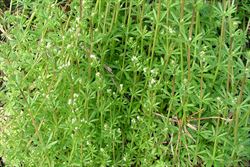
habit in flower (Photo: Sheldon Navie)
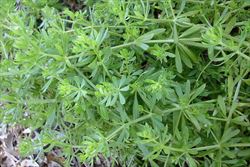
spreading habit (Photo: Sheldon Navie)
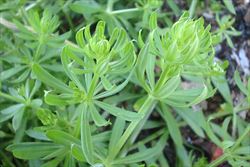
leaves borne in groups along the stems (Photo: Sheldon Navie)
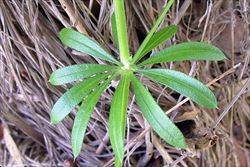
close-up of hairy leaves (Photo: Sheldon Navie)
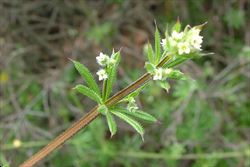
four-angled, prickly stems and flower clusters (Photo: Sheldon Navie)
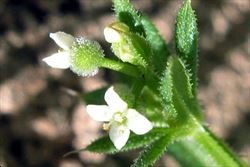
close-up of flowers (Photo: Greg Jordan)

young fruit (Photo: Sheldon Navie)
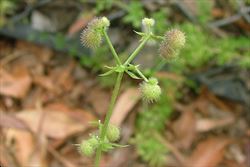
immature fruit with hooked hairs (Photo: Sheldon Navie)
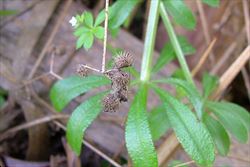
mature fruit (Photo: Sheldon Navie)

close-up of seeds (Photo: Steve Hurst at USDA PLANTS Database)
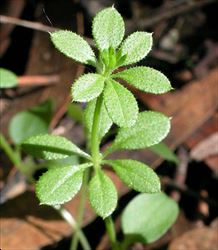
close-up of seedling (Photo: Greg Jordan)
Scientific Name
Galium aparine L.
Synonyms
Galium spurium L. var. echinospermum (Wallr.) HayekGalium vaillantii DC.
Family
Rubiaceae
Common Names
barweed, bed-straw, bedstraw, burrweed, catch weed, catchweed, catchweed bedstraw, cleavers, cleavers goosegrass, clivers, common bedstraw, common cleavers, everlasting friendship, goose grass, goosebill, goose-grass, goosegrass, grip grass, grip-grass, hayruff, hedge clivers, mutton chops, robin run over the hedge, robin-run-in-the-grass, scratch grass, small goosegrass, stickyweed, sticky-willy, stickywilly, velcro plant, white hedge
Origin
Native to Europe and western Asia (i.e. Eurasia). This species is now very widespread and its exact natural distribution is obscure.
Naturalised Distribution
This species is widely naturalised in Australia and is particularly common in the wetter temperate regions of south-eastern Australia (i.e. it is widespread and common in New South Wales, the ACT, Victoria, Tasmania and south-eastern South Australia). It is also occasionally naturalised in south-western Western Australia and in the cooler districts of south-eastern Queensland.
Habitat
This species is mostly commonly found growing in temperate environments, but sometimes also inhabits sub-tropical and semi-arid regions. It is a weed of crops, orchards, gardens, waste areas, disturbed sites, pastures, grasslands, open woodlands, closed forests and margins, waterways and wetlands.
Habit
A short-lived (i.e. annual) herbaceous plant with a scrambling or sometimes weakly climbing habit. Its stems grows up to 2 m long and are easily broken off.
Distinguishing Features
- a short-lived herbaceous plant with a trailing, scrambling or weakly climbing habit.
- its weak four-angled stems are covered in tiny backward-pointing prickles.
- its narrow leaves (10-80 mm long and 2-10 mm wide) are borne in groups of six to nine along the stems.
- its inconspicuous white flowers (about 1 mm long and 1-2 mm across) are borne in small clusters in the leaf forks.
- its two-lobed fruit (2-6 mm across) are held upright and covered in hooked bristles.
Seedling
The two seed leaves (i.e. cotyledons) are egg-shaped in outline (i.e. ovate) with slightly notched tips (i.e. emarginate apices). They are hairless (i.e. glabrous) and borne on slender stalks (i.e. petioles). The first ture leaves are borne in a group (i.e. whorl) of four to six. They are egg-shaped i.e. obovate) or club-shaped (i.e. clavate) in outline with shortly-pointed tips (i.e. mucronate apices) and hairy surfaces.
Stems and Leaves
The relatively slender (about 2 mm thick) and weak or slightly stiff stems are square in cross-section (i.e. quadrangular). They are rough to the touch and have a covering of tiny backward-pointing (i.e. recurved) prickles along their edges. The stems also have some hairs near their joints (i.e. nodes).
The stalkless (i.e. sessile) leaves are borne in groups of 6-9 at each of the stem joints (i.e. they are whorled or verticillate). These leaves (10-80 mm long and 2-10 mm wide) are narrow (i.e. linear) or lance-shaped (i.e. lanceolate) with pointed (i.e. mucronate) tips and tiny backward-pointing (i.e. recurved) prickles along their margins. Both leaf surfaces, but particularly the upper surfaces, are loosely covered with tiny hooked hairs.
Flowers and Fruit
The inconspicuous flowers (about 1 mm long and 1-2 mm across) are white in colour with four petals that are fused together near their bases. These flowers are arranged in small spreading clusters (containing 1-9 flowers) on short side branches (i.e. peduncles) up to 2.5 cm long that emanate from the leaf forks (i.e. axils). The individuals flowers are borne on shorter stalks (i.e. pedicels) 4-15 mm long and no not have any sepals. However, they do have four tiny yellow stamens and a two-lobed style, each lobe being topped with a rounded stigma. Flowering occurs mostly during spring and summer.
The fruit are two-lobed, kidney-shaped (i.e. reniform), and easily break into two one-seeded parts (i.e. mericarps) when mature. These small fruit (2-6 mm across) are densely covered with hooked hairs. They are green or purplish-green in colour when young, and later turning grey, greyish-brown or brown as they mature. The seeds are rounded, rough in texture, and 2-3 mm across.
Reproduction and Dispersal
This species reproduces by seed. These seeds are spread by water, wind and machinery, and in contaminated agricultural produce (e.g. fodder), soil and dumped garden waste. Because of the hooked hairs on the fruit, seeds also very easily become attached to clothing and animals.
Environmental Impact
Cleavers (Galium aparine) is regarded as an environmental weed in Victoria, Tasmania and New South Wales. It invades a variety of native habitats including dry coastal vegetation, coastal sand dunes, rocky sites, open woodlands, temperate rainforests, wetlands and riparian areas.
This species is thought to pose a very serious threat to one or more vegetation formations in Victoria (e.g. riparian forests and riverine escarpment scrub). Cleavers (Galium aparine) is present on numerous local environmental weed lists (e.g. in Nillumbik Shire, Monash City, Knox Shire, City of Banyule, Baw Baw Shire and the Goulburn Broken Catchment) and has invaded several conservation areas in this state (e.g. Phillip Island Nature Park, Rutherglen Nature Conservation Reserve, Organ Pipes National Park, Dreeite Nature Conservation Reserve and Pomborneit North Nature Conservation Reserve). It is also one of several weeds that are considered to be a major threat to the long-term survival of the threatened Strzelecki gum (Eucalyptus strzeleckii) in grassy woodlands in the Strzelecki Ranges in south-eastern Victoria. It and other weeds dominate the ground layer underneath populations of Strzelecki gum (Eucalyptus strzeleckii), especially on private land, and may prevent seedling recruitment of this species.
Cleavers (Galium aparine) has also been recorded in conservation areas in Tasmania (e.g. Greens Beach/Kelso Coastal Reserve, Don Reserve and Clayton Wetland) and South Australia (e.g. Cleland Conservation Park, Brownhill Creek Recreation Park, Onkaparinga River National Park, Mount Magnificent Conservation Park, Horsnell Gully Conservation Park and Cudlee Creek Conservation Park). It is also listed as a common environmental weed of moist sites in the Hunter Catchment and is a weed of internationally significant (i.e. Ramsar listed) wetlands in the Murray River catchment in New South Wales.
Other Impacts
Cleavers (Galium aparine) is a common weed of crops, orchards, gardens, and pastures in southern Australia. In pasture situations its prickly stems can cause injury, and so are not readily grazed by livestock. The fruit may also contaminate fleece, increasing vegetable fault in wool.
Legislation
This species is declared under legislation in the following states and territories:
- Western Australia: P1 - trade, sale or movement into the state prevented, and P2 - to be eradicated (throughout the entire state).
Management
For information on the management of this species see the following resources:
- the Western Australian Department of Agriculture and Food information page on this species, at http://www.agric.wa.gov.au.
Similar Species
Cleavers (Galium aparine) is very similar to false cleavers (Galium spurium), three-horned bedstraw (Galium tricornutum), slender bedstraw (Galium divaricatum) and small bedstraw (Galium murale). These species can be distinguished by the following differences:
- cleavers (Galium aparine ) has relatively slender (up to 2 mm thick) and somewhat stiff stems that are often more than 50 cm long. Its relatively large (10-80 mm long) leaves are arranged in groups (i.e. whorls) of six to nine along the stems. Its white flowers are arranged in relatively loose clusters and its relatively large fruit (2-6 mm across) are densely covered in hooked bristles.
- false cleavers (Galium spurium) has relatively thick (1-4 mm thick) and stiff stems that that are often more than 50 cm long. Its relatively large (12-62 mm long) leaves are arranged in groups (i.e. whorls) of six to ten along the stems. Its greenish-yellow flowers are borne in small dense clusters and its relatively small fruit (less than 3 mm across) are densely covered in hooked bristles.
- three-horned bedstraw (Galium tricornutum ) has relatively slender (up to 2 mm thick) and somewhat stiff stems that are often more than 50 cm long. It relatively large (10-50 mm long) leaves are arranged in groups (i.e. whorls) of six to eight along the stems. Its white flowers are arranged in small, relatively dense, clusters and its relatively large fruit (3-5 mm across) are turned downwards (i.e. deflexed) do not have any hairs or bristles (instead they are covered in small lumps known as tubercules).
- slender bedstraw (Galium divaricatum ) has very slender (about 1 mm thick) delicate stems that are usually less than 30 cm long. Its very small (less than 10 mm long) leaves are usually arranged in groups (i.e. whorls) of six to eight along the stems (except on flowering branches). Its white to yellowish-red flowers are borne singly or in pairs and its tiny fruit (0.5-1 mm long) are not covered in hairs or bristles (instead they are covered in small lumps known as papillae).
- small bedstraw (Galium murale ) has very slender (about 1 mm thick) delicate stems that are usually less than 15 cm long. Its very small (less than 10 mm long) leaves are arranged in groups (i.e. whorls) of three to six along the stems. Its white or yellowish-green flowers are borne singly or in pairs and its very small fruit (1-1.5 mm long) are covered in small hairs or bristles (particularly towards their tips).
Cleavers (Galium aparine) is also similar to some of the native bedstraws (Galium spp.), but these native species generally have leaves in groups (i.e. whorls) of three to five. It is also relatively similar to field madder (Sherardia arvensis) and Indian chickweed (Mollugo verticillata). However, field madder (Sherardia arvensis) has lilac to white stalkless (i.e. sessile) flowers that are borne in small dense clusters and Indian chickweed (Mollugo verticillata ) is a mostly hairless plant that has flowers with five petals.

